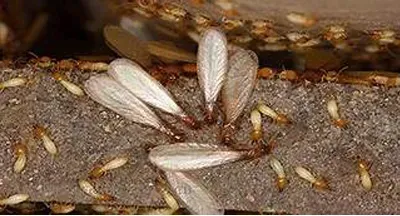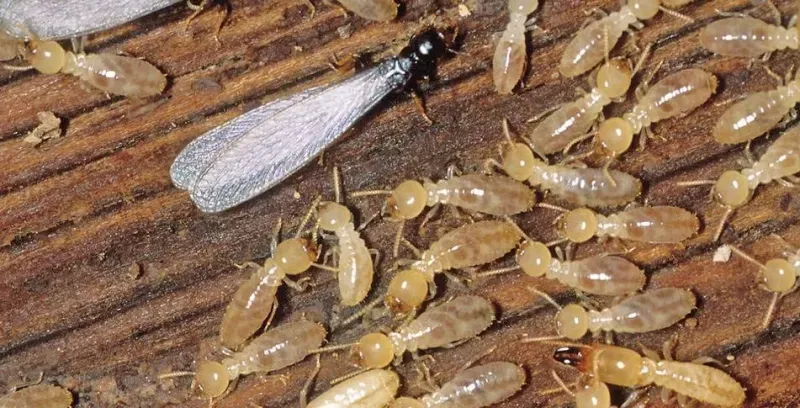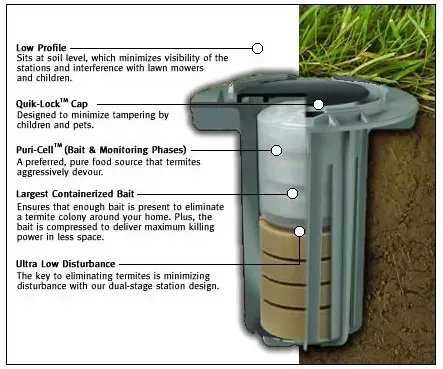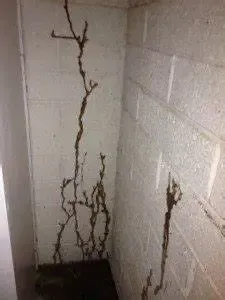Termites
There are two types of homes:
Those that have termites & those that will!

The First Signs
Subterranean termites cause approximately 5 billion dollars’ worth of damage every year and this damage is usually not covered by most home owner’s insurance. Annually termites do more damage than fires and flood combined.
The first evidence of a subterranean termite infestation may be the reproductives that are blackish gray with silver transparent wings and usually swarm in the spring through the summer months. Swarms are triggered by warm temperatures and rainfall. The termites will drop their wings after a short flight, pair off to mate and return to the ground to begin a new colony. These reproductive are often mistaken for winged ants.

Evidence of a swarm
Property owners may only see evidence of a swarm by finding the wings on a windowsill or near a heat or light source. Property owners sometimes believe they have destroyed the termites by spraying the swarmers with an over the counter insect spray. However, the ones you should be concerned about are the ones that cause structural damage to the property, which are the worker termites. Workers are cream or beige in color and are often hidden behind the walls, floor joists, insulation, they are not seen in the crawlspace because they can travel up through openings in foundation blocks.
Where They Hide
Just because you don’t see exploratory shelter tubes in your basement, garage, or crawlspace doesn’t mean you don’t have termites!
Any foundation, including cinder block structures, metal wall studding, metal roofs, bricks or stone foundation can be penetrated by subterranean termites that have small settlement cracks or expansion joints of .32 hundredths of an inch. Termites use this space to gain entrance to wood floors, paper from dry wall, floors joints, ceiling tile, furniture, books, certain fibers of carpets, etc., for cellulose which is their food source.
Workers subterranean termites re-enter the soil where the colony is located to feed the caste of the colony but the colony can also be located above ground if enough moisture can be obtained due to leaky roofs, gutter, or water line leaks within the interior of the structure.
Termites
There are two types of homes:
Those that have termites & those that will!

The First Signs
Subterranean termites cause approximately 5 billion dollars’ worth of damage every year and this damage is usually not covered by most home owner’s insurance. Annually termites do more damage than fires and flood combined.
The first evidence of a subterranean termite infestation may be the reproductives that are blackish gray with silver transparent wings and usually swarm in the spring through the summer months. Swarms are triggered by warm temperatures and rainfall. The termites will drop their wings after a short flight, pair off to mate and return to the ground to begin a new colony. These reproductive are often mistaken for winged ants.

Evidence of a swarm
Property owners may only see evidence of a swarm by finding the wings on a windowsill or near a heat or light source. Property owners sometimes believe they have destroyed the termites by spraying the swarmers with an over the counter insect spray. However, the ones you should be concerned about are the ones that cause structural damage to the property, which are the worker termites. Workers are cream or beige in color and are often hidden behind the walls, floor joists, insulation, they are not seen in the crawlspace because they can travel up through openings in foundation blocks.
Where They Hide
Just because you don’t see exploratory shelter tubes in your basement, garage, or crawlspace doesn’t mean you don’t have termites!
Any foundation, including cinder block structures, metal wall studding, metal roofs, bricks or stone foundation can be penetrated by subterranean termites that have small settlement cracks or expansion joints of .32 hundredths of an inch. Termites use this space to gain entrance to wood floors, paper from dry wall, floors joints, ceiling tile, furniture, books, certain fibers of carpets, etc., for cellulose which is their food source.
Workers subterranean termites re-enter the soil where the colony is located to feed the caste of the colony but the colony can also be located above ground if enough moisture can be obtained due to leaky roofs, gutter, or water line leaks within the interior of the structure.
Phillips can install in-ground monitors and baiting systems around property that may have inaccessible or low areas for the treatment for subterranean termites.
Phillips professional inspectors provide an inspection and treatment procedure customized for your property to guard against and prevent structural damage.



Phillips can install in-ground monitors and baiting systems around property that may have inaccessible or low areas for the treatment for subterranean termites.
Phillips professional inspectors provide an inspection and treatment procedure customized for your property to guard against and prevent structural damage.



Beckley: (304) 252-9234
Lewisburg: (304) 647-9903
Pineville: (304) 732-6298
Welch: (304) 436-2244
Charleston: (304) 346-6565
Logan: (304) 752-0349
Princeton: (304) 487-5789
Williamson: (304) 235-2113
You can also reach us at: [email protected]
© Copyright 2023 Phillips Termite and Pest Control, Inc.
Beckley: (304) 252-9234
Lewisburg: (304) 647-9903
Pineville: (304) 732-6298
Welch: (304) 436-2244
Charleston: (304) 346-6565
Logan: (304) 752-0349
Princeton: (304) 487-5789
Williamson: (304) 235-2113
You can also reach us at: [email protected]
© Copyright 2023 Phillips Termite and Pest Control, Inc.
Beckley: (304) 252-9234
Lewisburg: (304) 647-9903
Pineville: (304) 732-6298
Welch: (304) 436-2244
Charleston: (304) 346-6565
Logan: (304) 752-0349
Princeton: (304) 487-5789
Williamson: (304) 235-2113
You can also reach us at: [email protected]
© Copyright 2023 Phillips Termite and Pest Control, Inc.
